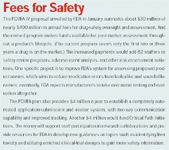Washington Report: Safety First
Pharmaceutical Executive
Critics asked for a reevaluation of new drugs a year after launch. FDA's plan to issue report cards on new drugs responds to that demand-but not completely.
THE INSTITUTE OF MEDICINE (IOM) issued a report last September urging the Food and Drug Administration (FDA) to change the way it operates, in order to achieve better balance in the agency's assessment of the risks and benefits of drugs. FDA commissioner Andrew von Eschenbach responded a few weeks ago with a detailed safety program. FDA plans to develop safety report cards on important new drugs, create an online drug-safety newsletter, and improve the agency's ability to detect safety signals by accessing more health system databases. The leaders of the Center for Drug Evaluation and Research (CDER) also promise to address the tension between pre- and post-approval staffs by orchestrating a "true culture change" that gives safety analysts more authority over regulatory decisions.

Jill Wechsler
The unstated goal of the program is to soften legislation that would require more significant organizational changes and impose new mandates on manufacturers and regulators alike. Senators Charles Grassley (R-IA) and Chris Dodd (D-CT) continue to back a bill establishing a separate drug-safety office at FDA. And Senators Edward Kennedy (D-MA) and Mike Enzi (R-WY) have offered a bill requiring risk-mitigation strategies for all new drugs and mandatory clinical-trial registration.
The FDA announcement covered activities the agency can implement on its own, as long as it gains sufficient funding. The plan does not address IOM proposals requiring congressional action, such as giving the agency authority to levy fines on companies that fail to complete promised post-approval studies. The agency also did not respond to recommendations for special warning symbols on high-risk products and limits on DTC advertising of newly approved drugs, an issue that is gaining attention in Washington. But it seems clear that if FDA and industry want Congress to reauthorize the Prescription Drug User Fee Act (PDUFA) by fall, they probably will have to accept some new legislative requirements designed to ensure the safety of medicines.

Fees for Safety
More Assessment
The FDA plan addresses IOM's recommendations on assessment and communication of risk information. But some of its proposals fall short of what critics had demanded. For example, IOM had suggested a scheduled reevaluation of new drugs a year or so after launch, as would occur under a conditional-approval system. The pilot plan to issue report cards on newly approved drugs responds to that demand—but not completely. FDA proposes to evaluate adverse-event reports, additional clinical studies, and epidemiologic information, starting with two or three new molecular entities (NMEs). These just now are being selected for the pilot, so the first assessments won't appear for at least 18 months. But the reports will be made public, and the program could be extended to all new drugs if it seems to provide a more complete picture of safety issues throughout the product lifecycle.
There also has been a clamor for FDA to publicly disclose more drug safety information from post-approval studies and adverse-event reports. The industry, arguing that sponsors and regulators should have the opportunity to evaluate safety information before publicizing it, has opposed the proposal. FDA has offered a compromise: It dropped its earlier proposal for a "Drug Watch" Web site and proposes to launch an online newsletter with summaries of FDA post-marketing drug reviews, emerging safety issues, and information on newly approved products. The summaries will be cleansed of confidential commercial information.
The Kennedy-Enzi bill would require all new-drug applications (NDAs) to include risk management plans (RiskMAPS), and the IOM report urged further evaluation of such approaches. FDA says it will review one or two RiskMAPS every year and post the results to help assess how effectively these programs address serious safety issues.
Another hot issue is how to ensure the independence of FDA advisory committees. These panels were attacked as industry pawns during the Vioxx (rofecoxib) controversy. FDA's response is to establish clearer procedures for dealing with conflicts of interest, for presenting postmarket safety issues to advisory committees, and for bringing additional pharmacoepidemiology experts into advisory committee meetings that deal with safety issues. FDA also is establishing a new advisory committee on communication to gain more outside expertise on risk and crisis communication. These moves may not satisfy those who want to rid the committees of all experts with industry ties, but FDA hopes that more transparent procedures will address the most important concerns.
A central issued raised by IOM is that CDER's culture is pro-approval and has relegated safety reviewers to a secondary role in evaluating new drugs. Instead of establishing a separate drug-safety office, CDER director Steven Galson plans organizational changes to give CDER's Office of Surveillance and Epidemiology (OSE) greater authority for approving NDAs and requesting post-market studies and label changes. Each new-drug review office will have a high-level safety manager; meanwhile a new electronic tracking system will integrate multiple agency databases.
Stress on Science
An underlying theme of FDA's drug safety program is that new developments in biomedical science and information technology can provide more efficient ways to address drug safety early in drug development and to quickly detect safety problems after a drug goes to market. FDA deputy commissioner Janet Woodcock, now the agency's chief medical officer, heads up a range of efforts, many of them launched under the Critical Path Initiative, to accelerate risk assessment.
Collaborations involving FDA, industry, and academia, for example, are developing new tests for organ toxicity and cardiovascular risk. The Predictive Safety Consortium is sharing data to cross-validate preclinical safety markers. Another consortium of manufacturers, FDA, and the National Institutes of Health plans to assess biomarkers that can spur development of new treatments, beginning with lung cancer and lymphoma. And a new Serious Adverse Event Consortium plans to identify and validate genetic variants that may help predict the risk of drug-induced reactions, starting with liver disease and serious skin rashes.
These and many other initiatives are described more fully in a January report from FDA on progress made in implementing Critical Path opportunities during 2006. The goal is to "build safety into products" by better understanding the genetic basis of adverse events, explained Woodcock. This approach can screen out toxic compounds early on and identify patients most likely to have adverse reactions—or to respond well—to a test medicine. The aim, she said, is to "make products safer from the get-go."
At the same time, electronic health information systems provide new opportunities for FDA and manufacturers to tap into richer information sources on drug utilization and health outcomes. FDA now is collaborating with the Veterans Administration, Medicare, and other government agencies to access data on medical product use in public and private healthcare systems. A proposed FDA Sentinel Network would link multiple databases to establish a national medical product-safety network.
While media hype about drug safety may raise inappropriate fears in the public, that same hype also could boost adverse-event reporting and awareness of drug–drug interactions and the need to ensure proper use of medications. Woodcock envisions establishing "seamless links" to information on product use and medical consequences through electronic medical records. "As chief medical officer at FDA," she said, "I'm committed to lead in the development and use of these new tools."
Jill Wechsler is Pharm Exec's Washington correspondent. She can be reached at jwechsler@advanstar.com

Addressing Disparities in Psoriasis Trials: Takeda's Strategies for Inclusivity in Clinical Research
April 14th 2025LaShell Robinson, Head of Global Feasibility and Trial Equity at Takeda, speaks about the company's strategies to engage patients in underrepresented populations in its phase III psoriasis trials.
Beyond the Prescription: Pharma's Role in Digital Health Conversations
April 1st 2025Join us for an insightful conversation with Jennifer Harakal, Head of Regulatory Affairs at Canopy Life Sciences, as we unpack the evolving intersection of social media and healthcare decisions. Discover how pharmaceutical companies can navigate regulatory challenges while meaningfully engaging with consumers in digital spaces. Jennifer shares expert strategies for responsible marketing, working with influencers, and creating educational content that bridges the gap between patients and healthcare providers. A must-listen for pharma marketers looking to build trust and compliance in today's social media landscape.